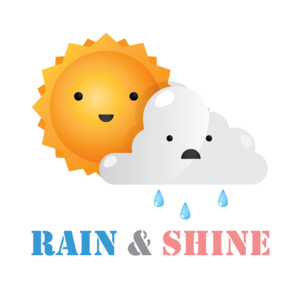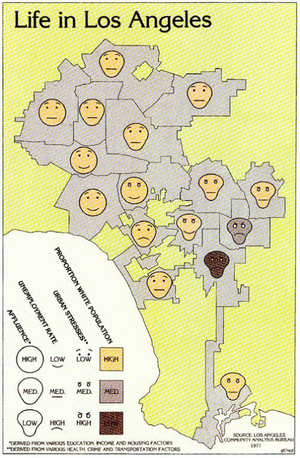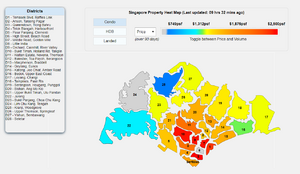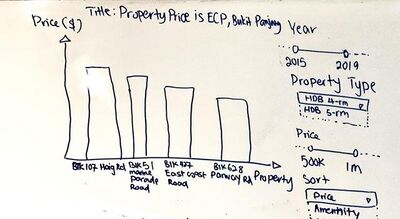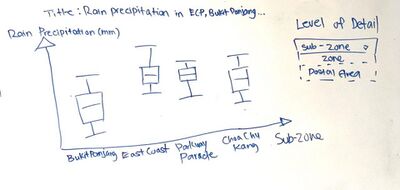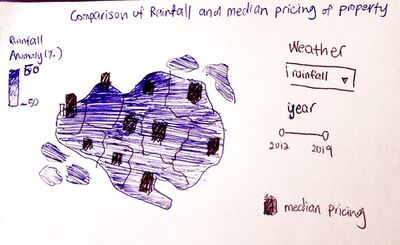Group02 proposal v2
|
|
Contents
PROBLEM & MOTIVATION
Problem
When it comes to purchasing or renting a property, there are many factors that go into a buyer’s consideration before he makes the final decision. The primary concern for buyers is the pricing of the property [1]. However, our group identified that there are also secondary concerns such as the weather and the amenities available that do influence the buyer’s final decision to purchase the property. There are limited tools available to help property buyers to identify areas that suit their needs/preferences best. The current tools that are available are only optimal to suit one category of concern, but fails when we try to use more categories to make our visualization.
For example, different people have different preferences for the weather. Some may prefer sunny weather while others prefer it to rain all the time. Currently, there are tools to find weather information, and property prices information, but not both at the same time.
Motivation
Through our visualization, the group hopes to assist users to be able to easily visualize a home of his dreams in different aspects beyond mere prices. Our visualization will incorporate data from property prices, weather and amenities to identify the accessibility of the area and help our users to justify the real value of the property. With our visualization dashboard, users will be able to identify properties that they truly desire.
OBJECTIVES
We aim to provide an interactive visualization dashboard to assist property seekers with identifying the housing area that best suits their needs with visualization information such as:
- Insights on the weather (which consists of the Rainfall Precipitation, Temperature and Wind speed) of each postal area.
- Insights on the available amenities within the proximity of the selected geo boundary.
- Insights on the distribution of commercial and residential prices for each postal area over the past few years.
Target Group:
- Property buyers with weather preferences
- Commerical buyers who wants to open a shop
DATASET
The Data Sets we will be using for our analysis and for our application is listed below:
| Data/Source | Variables/Description | Rationale Of Usage |
|---|---|---|
|
Temperature and Rainfall Data |
|
This dataset covers a good time series of Singapore's weather from 2012 to 2019 across different weather categories. Our team wish to spot the trend or pattern of Singapore's climate in every town if possible. |
|
Amenities Location Data |
|
The data set will be used to anchor the amenities available for the selected property in a specified range. Note: We will be looking into the API and use the JSON format to extract the geocoordinate for our amenities. Use both links to ensure we do not miss out any possible location. |
BACKGROUND SURVEY OF RELATED WORK
Below are a few visualizations and charts we considered making for our projects.
| Visual Considerations | Insights / Comments |
|---|---|
Title: Qualitative Thematic Map Source: https://mapdesign.icaci.org/2014/12/mapcarte-353365-life-in-los-angeles-by-eugene-turner-1977/ |
One of the items that we looked at is this qualitative thematic map that was covered in class. From our initial brainstorming of ideas, we intend to look at various factors that a buyer will look at, giving the buyer a high level overview of the different areas and whether it fits the criterias that he chooses. How we will adapt ideas from this graph is for us to allow for the users to make a few selections of multiple factors. Then based on which criterias the different properties in the different subzones are able to meet, we are able to choose different shapes, colours to represent the zone.
|
Title: Whisker plot of temperature Source: https://www.ck12.org/statistics/box-and-whisker-plots/rwa/The-Ways-of-Weather/ |
We are able to see the temperature for the selected area over the course of a year. The whisker plots are able to show the upper and lower boundaries of temperature, and we can observe that the temperature gradually rises to a peak from Jan to Aug, before decreasing until December. We hope to apply this chart to display the rainfall for a selected area over the course of a year. This allows buyers to be able to better understand the rainfall pattern in the area so that he is able to better understand if the area suits his preferences. |
Title: Heatmap of rainfall Source: https://www.shanelynn.ie/analysis-of-weather-data-using-pandas-python-and-seaborn/ |
This is a heatmap of daily rainfall. Darker colours of red represent heavier rainfall. Another way to have a visualization to understand the patterns of rainfall. Through this, we are able to quickly see how many days in a year where there is rain for a selected subzone. Assuming that a potential buyer is interested in a property that sees more sunlight, he will be more interested in a subzone where the graph looks brighter. On the other hand, if the buyer is interested in a property that is always rainy, he would be interested in an area where the graph looks darker. |
Title: Spatial Interpolation Source: https://www.srx.com.sg/heat-map/ |
This graph shows the property prices in Singapore for different property types. The user can choose to select different property types, and the graph will update to show only the selected property type. A variety of colours are chosen here to display different levels of prices. Based on our problem, there are 2 key aspects that we are looking at: Prices and Weather. One way this kind of visualization could be utilized by our group is for us to use this to display prices or Weather in Singapore across all subzones. By charting either prices or the various weather types over a map of Singapore, the user will be able to quickly gain an understanding of how the different criteria that he can choose will be like across Singapore.
|
KEY TECHNICAL CHALLENGES & MITIGATION
| No. | Challenge | Description | Mitigation Plan |
|---|---|---|---|
| Software Challenge | Unfamiliarity of visualisation tools such as R, R Shiny, Tableau. |
| |
| Programming Challenge | Inexperince with data cleaning and transformation using R |
| |
| Workload Constraint | Time and Workload Constrains |
| |
| Dataset Complexity |
Our have different data from multiple sources in multiple different formats, hence we foresee a huge challenge in standardizing the data
|
|
STORYBOARD
| Dashboards | Description |
|---|---|
Dashboard 1: Isopleth Map for Weather |
Our group plans to do an Isopleth Map which reflects the weather distribution based on the year, month and locations. This chart will show the data at a high level for users to identify which area is more rainy than average and which less rainy throughout the filtered Month/Year Period. Similarly, our team plans to do another Isopleth Map to show the distribution of the temperature throughout the whole of Singapore. The purpose of this chart is to understand and identify the raining patterns of Singapore throughout the past 20 years so as to find out if there is a climate change and if global warming is affecting the weather in Singapore. Filters used includes:
|
Dashboard 2: Property prices in Postal Areas{Based on Users selected areas in storyboard 1} |
The purpose of this chart is to show a detailed breakdown of the properties that meet the requirements of the Users based on his/her filters and User's shortlisted area(s) in the chart from Dashboard 1.
|
Dashboard 3: Distribution of Rain Precipitation Amount/ Temperature/ Wind Speed in Postal Areas{Based on Users selected areas in Dashboard 1} |
The purpose of this chart is to show a detailed breakdown of the weather (which includes Rain Precipitation Amount/ Temperature/ Wind Speed) for User’s shortlisted area(s) from the chart in Dashboard 1.
|
Dashboard 4: Comparing Rainfall {selected weather} and the median pricing of All Properties{selected property type} |
The chart in this storyboard reflects a combination of two thematic maps, a bar chart map as well as a spatial interpolation map. Similar to the chart in Dashboard 1, this chart will show data at a high level for users to identify which area meets their needs in a glance. However, this chart is more-straightforward as the results shown in this chart is more clear cut and less informative.
|
MILESTONES
COMMENTS
| No. | Name | Date | Comments |
|---|---|---|---|
| 1. | (Name) | (Date) | (Comment) |
| 2. | (Name) | (Date) | (Comment) |
| 3. | (Name) | (Date) | (Comment) |
